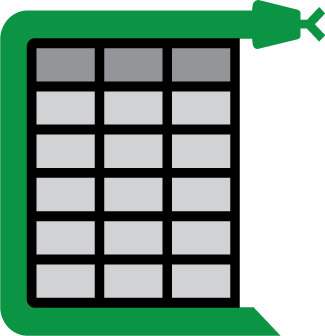Introduction¶
The Camelot Project¶
The PDF (Portable Document Format) was born out of The Camelot Project to create “a universal way to communicate documents across a wide variety of machine configurations, operating systems and communication networks”. The goal was to make these documents viewable on any display and printable on any modern printers. The invention of the PostScript page description language, which enabled the creation of fixed-layout flat documents (with text, fonts, graphics, images encapsulated), solved this problem.
At a high level, PostScript defines instructions, such as “place this character at this x,y coordinate on a plane”. Spaces can be simulated by placing characters relatively far apart. Extending from that, tables can be simulated by placing characters (which constitute words) in two-dimensional grids. A PDF viewer just takes these instructions and draws everything for the user to view. Since a PDF is just characters on a plane, there is no table data structure that can be extracted and used for analysis!
Sadly, a lot of today’s open data is trapped in PDF tables.
Why another PDF table extraction library?¶
There are both open (Tabula, pdf-table-extract) and closed-source (smallpdf, PDFTables) tools that are widely used to extract tables from PDF files. They either give a nice output or fail miserably. There is no in between. This is not helpful since everything in the real world, including PDF table extraction, is fuzzy. This leads to the creation of ad-hoc table extraction scripts for each type of PDF table.
Camelot was created to offer users complete control over table extraction. If you can’t get your desired output with the default settings, you can tweak them and get the job done!
Here is a comparison of Camelot’s output with outputs from other open-source PDF parsing libraries and tools.
What’s in a name?¶
As you can already guess, this library is named after The Camelot Project.
Fun fact: In the British comedy film Monty Python and the Holy Grail (and in the Arthurian legend depicted in the film), “Camelot” is the name of the castle where Arthur leads his men, the Knights of the Round Table, and then sets off elsewhere after deciding that it is “a silly place”. Interestingly, the language in which this library is written (Python) was named after Monty Python.
Camelot License¶
MIT License
Copyright (c) 2019-2021 Camelot Developers Copyright (c) 2018-2019 Peeply Private Ltd (Singapore)
Permission is hereby granted, free of charge, to any person obtaining a copy of this software and associated documentation files (the “Software”), to deal in the Software without restriction, including without limitation the rights to use, copy, modify, merge, publish, distribute, sublicense, and/or sell copies of the Software, and to permit persons to whom the Software is furnished to do so, subject to the following conditions:
The above copyright notice and this permission notice shall be included in all copies or substantial portions of the Software.
THE SOFTWARE IS PROVIDED “AS IS”, WITHOUT WARRANTY OF ANY KIND, EXPRESS OR IMPLIED, INCLUDING BUT NOT LIMITED TO THE WARRANTIES OF MERCHANTABILITY, FITNESS FOR A PARTICULAR PURPOSE AND NONINFRINGEMENT. IN NO EVENT SHALL THE AUTHORS OR COPYRIGHT HOLDERS BE LIABLE FOR ANY CLAIM, DAMAGES OR OTHER LIABILITY, WHETHER IN AN ACTION OF CONTRACT, TORT OR OTHERWISE, ARISING FROM, OUT OF OR IN CONNECTION WITH THE SOFTWARE OR THE USE OR OTHER DEALINGS IN THE SOFTWARE.

